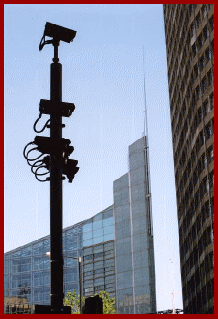| ||||||||||||||||||||||||||||||
Welcome to the | ||||||||||||||||||||||||||||||
 | ||||||||||||||||||||||||||||||
 | ||||||||||||||||||||||||||||||
The complete A to Z ... | ||||||||||||||||||||||||||||||
Having selected the very best CCTV equipment that money can buy, the next obvious consideration is how to move the picture signals around. Standard copper cables traditionally either ‘co-axial’ (unbalanced) or to a much lesser degree ‘twisted pair’ (balanced), provide a relatively inexpensive and user friendly transmission medium. Just recently, renewed interest has been shown in integrating Closed Circuit Television into existing building computer networks and indeed the Internet, although in relative terma it’s still very much in its infancy. Established high efficiency techniques such as fibre optic cable are already proven, albeit at a much higher cost than copper cable. Radio transmission has been around for an awfully long time, although unlike the much higher frequency ‘Microwave’ link, it is unfortunately not legal for video use in the United Kingdom. Transmission using Telephone circuits and mobile (cellular) phones, each present new and affordable opportunities for relaying images, whilst specialist techniques such as short range ‘Laser links’ and mains borne encrypted signals all have a specific role to play, in key situations. To find out more about the various transmission options, read on :- Copper Cable transmission - Unbalanced co-axial may well be a proven favourite, but what of balanced twisted pair as an alternative? | ||||||||||||||||||||||||||||||
 | ||||||||||||||||||||||||||||||
IMPORTANT: No material may be reproduced, copied or redistributed from this site, © doktorjon.co.uk 2004 - 2008 Homepage...:...Gateway...:...Technical Gateway....:....Quickfind Index....:....Equipment Directory | ||||||||||||||||||||||||||||||

